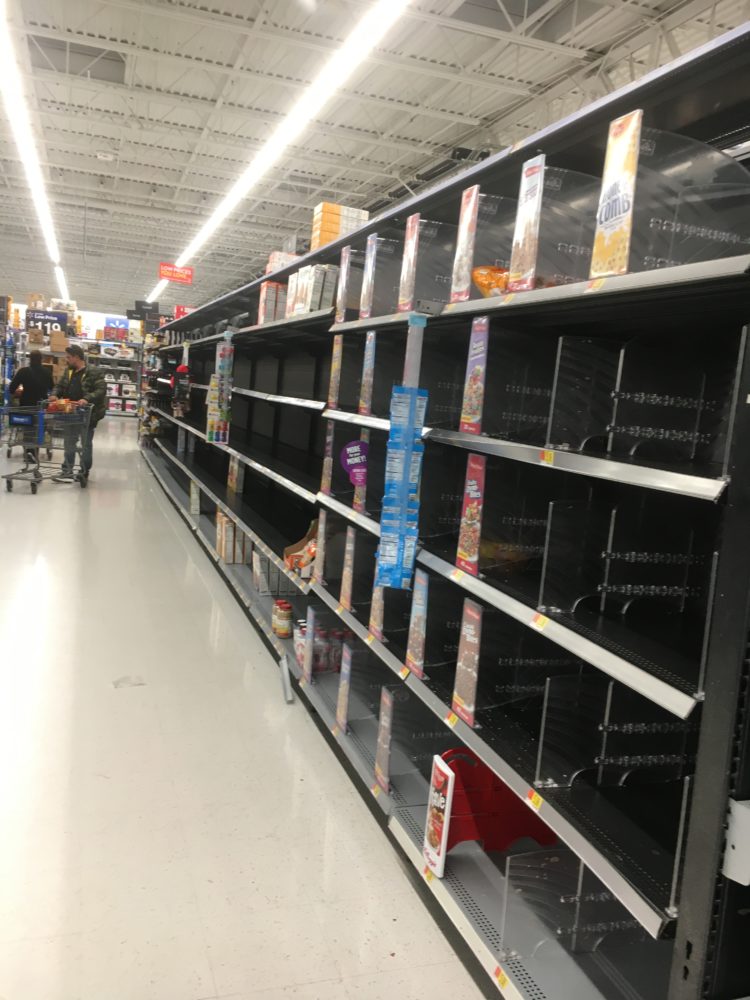
By Kayla Hoang
As the COVID-19 virus continues to spread, the conditions of businesses, from grocery store chains to local and family-owned businesses, face the problem of keeping business consistent with fluctuating customer attendance.
Despite encouragement for social distancing, people flock to hoard essentials due to heightened concerns regarding the spread of COVID-19 and uncertainty of how it might affect American lives. The rapidly-emptying shelves of water bottles, food products, toilet paper and sanitation supplies and growing demand for such products put an immense strain on grocery stores.
Customers’ hoarding of supplies in grocery stores has also raised concerns on whether there’ll be enough to provide for those who are most vulnerable: low-income families, the disabled and the elderly.
“If we have any elderly patrons inside the store, we do whatever we can to help expedite their visits,” one worker at the supermarket chain Aldi said. “So get them in and out as safe as possible.”
Some stores have responded by raising prices on their items, others have dealt with heavy customer traffic by introducing new regulations.
Multiple areas have limited store hours to support vulnerable groups of people. On March 18, Stater Bros. Markets opened all locations at 7:45 a.m.―15 minutes earlier than their usual opening time―to provide a quick window for seniors to shop.
Chain stores, such as Walmart and Costco, recently put limits on the number of high-demand items that consumers are allowed to purchase, from food products such as eggs and milk to personal hygiene products such as hand sanitizer and toilet paper.
“Luckily, [the workers are] prepared where we’re staffed and [items are] stocked and, you know, it’s just like anything else,” the Aldi worker said in response to the recent influx of customers. “You gotta take it in stride and not freak out and keep calm as best you can because if we lose our cool, the customers lose their cool.”
But even though customers flood grocery stores and supermarkets in search of essentials to last themselves months without leaving the safety of their homes, local restaurants, especially Asian-owned establishments, struggle financially.
With governments and health officials continually discouraging large gatherings and encouraging social distancing, restaurants have experienced major declines in customer attendance and sales.
On March 15, governments throughout Southern California asked sit-down bars and restaurants to shut down with the exception of drive-throughs, take-out and delivery. This will inevitably worsen the already declining customer attendance and further hurt the business of affected restaurants. It is unknown if this will reduce the loss of sales for restaurants.
Some restaurants have already shut down prior to the order, but food service industries don’t always provide paid sick leave or compensation for their workers.
Another reason some establishments are experiencing a severe drop in customers is due to increasing xenophobia as a result of the COVID-19. The virus’ origin in Wuhan, China has sparked an unreasonable reaction as people completely halt visits to Chinese or Asian-owned businesses in general. Owners struggle to stay afloat at this time, but it is unclear how long the stigma will remain.
The predicted peak for the COVID-19 virus varies. President Donald Trump said that the United States may be coping with the virus until July or August. Chinese physician Zhong Nanshan predicted the peak to have been around the end of February, and other epidemiologists predict the COVID-19 peak to be months from now.
Market strategist Art Hogan predicts that the stock market will continue to worsen before coronavirus cases peak in the US, further hurting the economy and along with it, American businesses and workers.
These contradictory predictions have led citizens to be unsure about the how far and soon the virus will spread, which can lead to assuming the worst. This will inevitably result in a larger rush for stores to provide enough supplies to fulfill customers’ panic-hoarding for supplies in the coming months, and restaurants and local establishments will continue to struggle to alleviate financial losses.
Camelia Heins and Arden Nguyen contributed to this story





